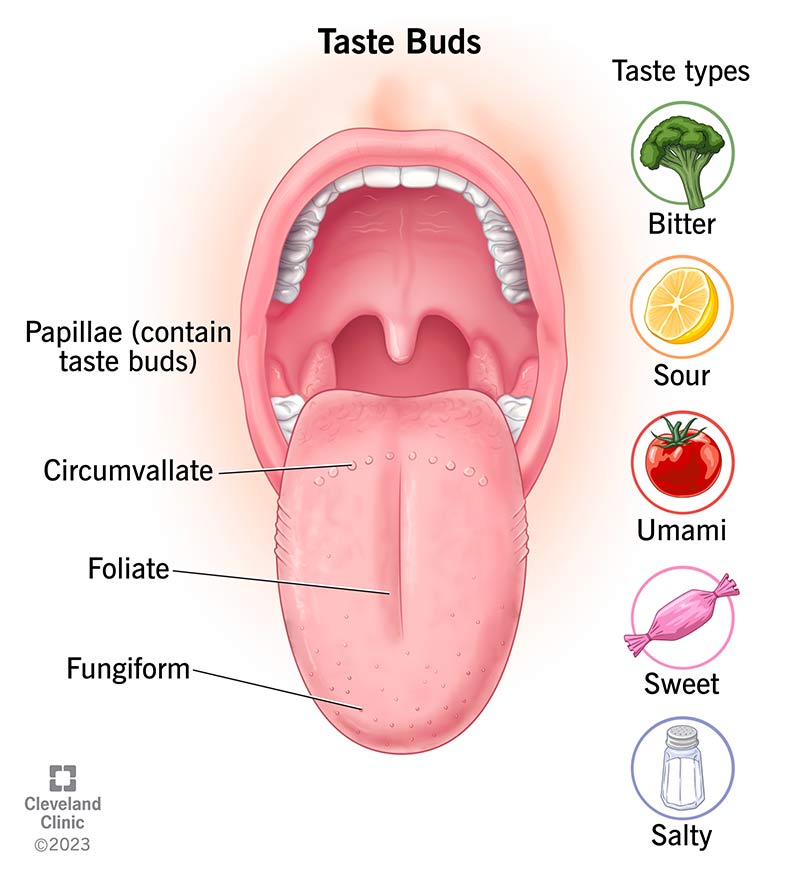Taste buds are cells on your tongue that allow you to perceive tastes, including sweet, salty, sour, bitter and umami. Taste buds regenerate approximately every 10 days, which means injured taste buds usually repair on their own.
Advertisement
Cleveland Clinic is a non-profit academic medical center. Advertising on our site helps support our mission. We do not endorse non-Cleveland Clinic products or services. Policy

Taste buds are tiny sensory organs that allow you to experience taste. They’re located inside the tiny bumps covering your tongue called papillae. Taste buds let you know what you’re eating and drinking and whether it tastes “good” or “bad.” This information makes eating pleasurable, which helps keep your body nourished. Your taste buds also alert you when something isn’t safe to consume, like spoiled milk or rotten meat.
Advertisement
Cleveland Clinic is a non-profit academic medical center. Advertising on our site helps support our mission. We do not endorse non-Cleveland Clinic products or services. Policy
Taste buds detect five basic tastes, including:
Your taste buds experience these tastes in various combinations, making your experience of food and drink all the more complex. For example, taste buds may register a food as mostly sweet but also salty and umami. Or, a drink may taste mostly bitter but also sweet.
Advertisement
Taste buds work with the olfactory receptors in your nose to allow you to experience flavor. When you chew food, your teeth and the saliva in your mouth work together to break it down. This breakdown releases chemicals from the food that flow to your taste buds. These chemical signals also travel up your nasal passages to receptors in your nose. Together, these signals from your nose and mouth allow you to experience flavor. Think of, for instance, how holding your nose doesn’t prevent you from tasting something, but it can change the flavor or dampen its intensity.
Other cells in your mouth and throat contain receptors that register how hot or cold a food or drink is. “Hot” includes temperature and spice. “Cold” includes temperature and certain flavor sensations, like mint or eucalyptus.
Multiple sensitive cells work together to shape your experience of eating and drinking.
The average adult has anywhere from 2,000 to 10,000 taste buds. We lose taste buds as we age, which means that children have more taste buds than adults. Sizes and numbers of taste buds vary from person to person.
These differences mean that, although everyone detects the same five tastes, perceptions and experiences of these tastes vary.
Taste buds come in different sizes. On average, they have a diameter of about one-thirtieth of a millimeter and a length of one-sixteenth of a millimeter.
Taste buds primarily cover your tongue. To a lesser extent, you also have taste buds on the roof of your mouth and in your throat. The taste buds on your tongue are housed inside visible bumps called papillae. There are three types of papillae that contain taste buds:
It’s a common misconception that your tongue contains taste zones, or specific regions devoted to just one taste. Instead, taste buds that detect sweet, salty, bitter, sour and umami are scattered throughout your tongue. Some parts of your tongue are a bit more sensitive to certain tastes.
For example, taste buds on the back of your tongue are especially sensitive to bitter tastes. This is likely an evolutionary feature. Toxic substances often contain compounds your taste buds register as bitter and unpleasant. Identifying something as unpleasant (and potentially hazardous) before you swallow can save your life.
Advertisement
Imagine a collection of cells arranged like a peeled orange or rosebud. At the top of the rosebud, a slight opening called a taste pore allows food and drinks to come into contact with the cells inside that detect taste.
A taste bud is a collection of cells grouped inside the bumps on your tongue called papillae. A taste bud includes:
Basal cells develop into new taste receptor cells every week or two (10 days on average). Our taste buds decrease as we age, which means that your perception of taste changes at different stages of life. The foods you love as an adult may differ from those you love as a child. Similarly, taste perception changes as you transition through adulthood.
Advertisement
A group of conditions called taste disorders changes your sense of taste. They include:
In addition, any of the following can affect your taste buds, causing food to taste differently:
The good news is that your taste buds repair and regenerate regularly. Injured taste buds usually heal on their own. Still, repeated damage — from frequent infections and smoking — can prevent your taste buds from healing and impact your sense of taste.
To prevent injuring a taste bud:
Advertisement
Taste buds are tiny sensory organs with a huge job. Along with sensors in your nose, they allow you to experience flavor. If you’ve injured a taste bud, chances are it’ll repair in a week or two so you can enjoy food again. In the meantime, prevent injury by allowing foods and drinks to cool before eating or drinking. Avoid using tobacco products, which can cause long-term damage to your taste buds.
Cleveland Clinic’s primary care providers offer lifelong medical care. From sinus infections and high blood pressure to preventive screening, we’re here for you.

Last reviewed on 02/07/2023.
Learn more about the Health Library and our editorial process.